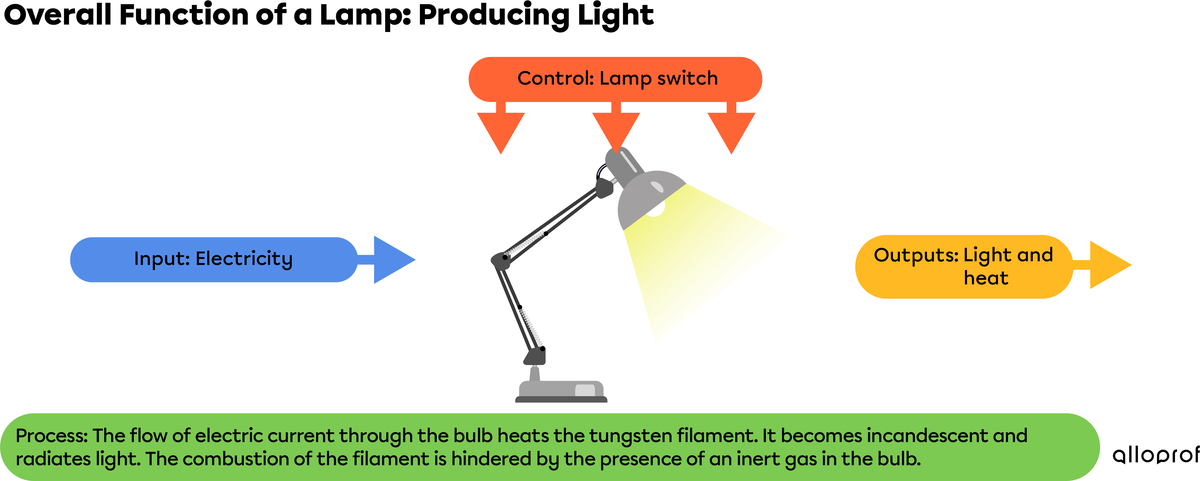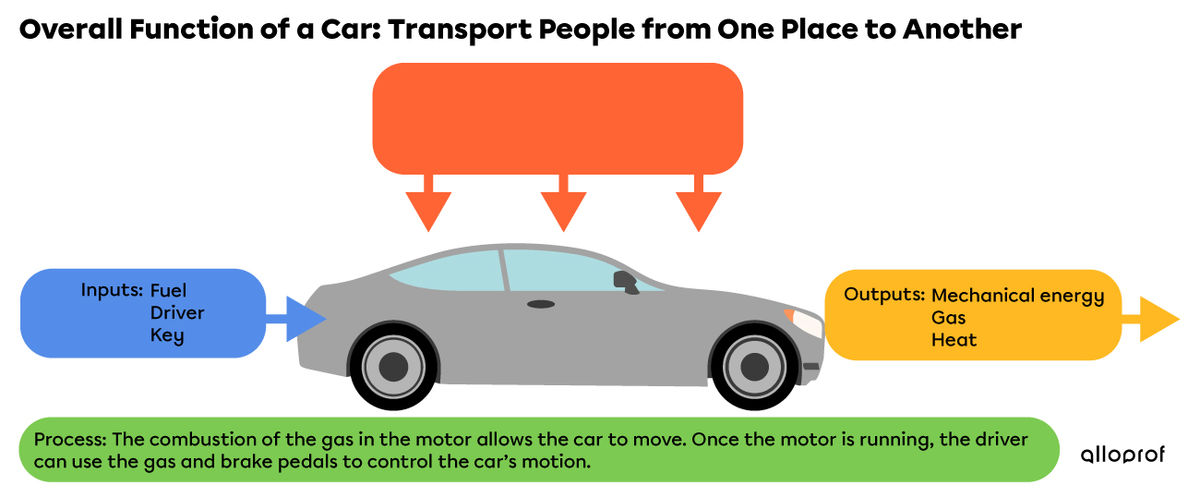The characteristics of a system are the qualities that make it possible to describe a technological system.
All technological systems, whether simple or complex, share certain essential characteristics. A technological system is described using five characteristics.
|
Characteristic of a technological system |
Example of a lamp |
|---|---|
|
Generate light |
|
|
Electricity |
|
|
Light and heat |
|
|
Incandescence (emission of light from a tungsten filament during the passage of an electric current) |
|
|
Light switch |
The characteristics of a system are often illustrated in the form of a diagram.

Diagram displaying a lamp’s technological characteristics
The overall function of a system describes the purpose of an entire system — what it was designed to do.
To define the overall function of a system, simply ask the following question: "what is the main purpose of the system?" For example, the overall function of a bicycle is to enable a person to move quickly by operating a pedal; that of a wind turbine is to transform the energy of the wind into electrical power; that of a kettle is to produce thermal energy to boil water.

All systems require inputs. A simple system, such as an incandescent bulb, requires only one input: electricity. However, in the case of more complex technological systems, many inputs are required to operate the system.

An output is something that comes out of a system. It may or may not be wanted.
Technological systems make it possible to transform a set of resources (inputs) into something else, namely the products, which are called outputs. All systems require inputs to function. During the operation of the system, these inputs produce outputs that are made of matter or energy.
There are planned and desired outputs, which are called outcomes. For example, a car allows travel as an outcome. However, an output rarely occurs on its own. Some outputs are planned, but not desired. In the case of a motor vehicle, exhaust gases which pollute the atmosphere, waste heat and other waste produced are unwanted outputs. The outputs obtained have an added value compared to the inputs when they have passed through the system.

The process is a sequence of actions performed by the system to transform the inputs in order to fulfill the requested overall function.
A process can act in two ways — either chemically or physically. For example, a process can modify a material to give it a new shape should a physical change occur. This is what happens, for example, when a dryer dries damp clothes. On the other hand, the process can be a chemical change, as in the case of gasoline, which is burned in a combustion engine. All processes transform objects with certain characteristics into objects that have different characteristics. When separating cream from whole milk, for example, whole milk is placed in a centrifugal separator. The result is cream and skimmed milk. This is called skimming milk. This separation process uses centrifugal force.

The controls of a system are used to activate, deactivate, or modify the operation of the system. There are several types of controls: mechanical, electrical, and optical.
For example, the operation of a television requires the use of a remote control. In addition to these physical controls, there may be some other constraints that need to be met to ensure the functioning of the system. For example, an electrical power source is needed to operate a lamp or the presence of the user is necessary to operate the stapler.
These control data can be classified into four categories:
-
energy constraints;
-
configuration constraints (program, cycle, etc.);
-
adjustment constraints (temperature, speed, pressure, etc.);
-
operating constraints (power on/off, start, operational sequence, etc.).

Here are examples of diagrams for characteristics of other technological systems.

Diagram of technological characteristics for a washing machine

Diagram of technological characteristics of a stapler

Diagram of technological characteristics of an electric guitar